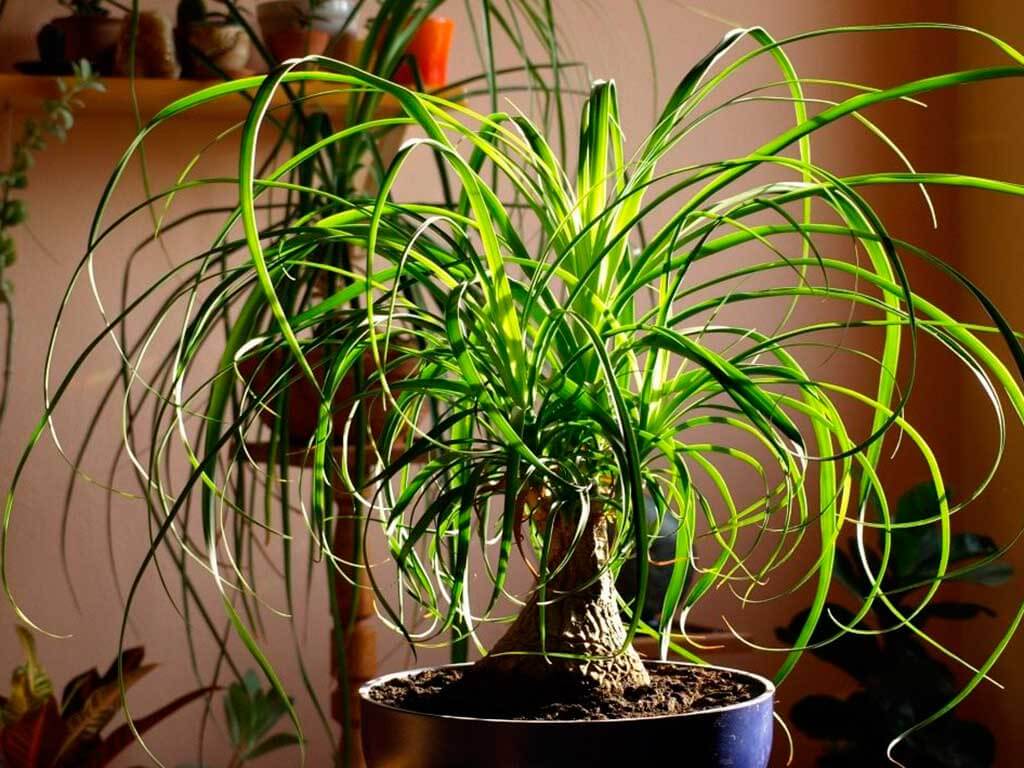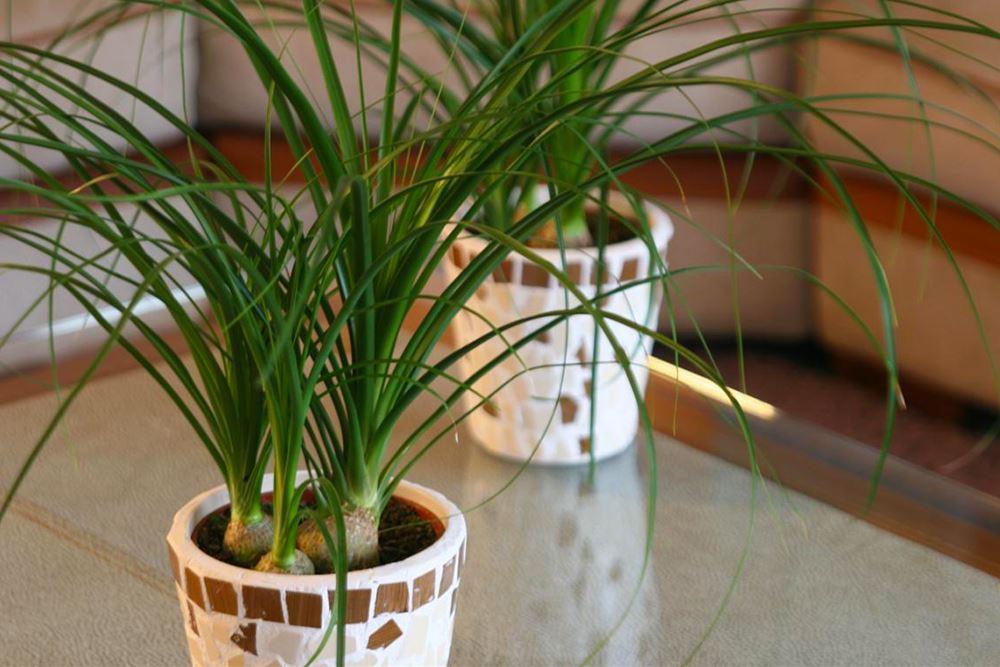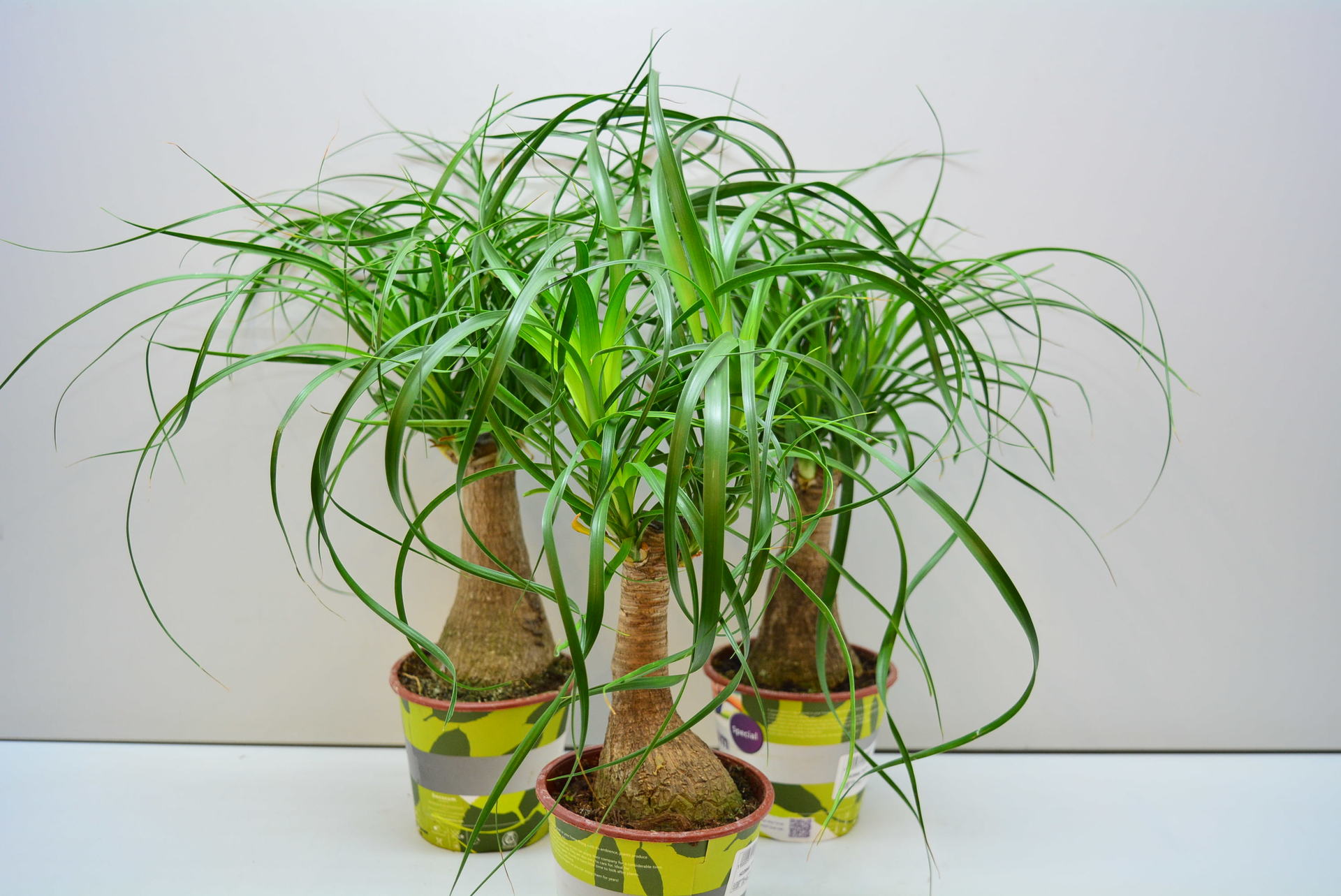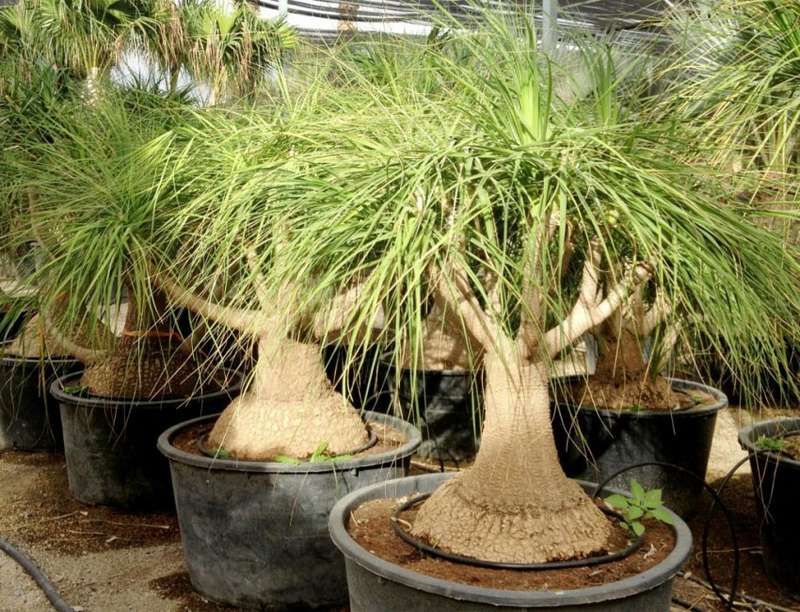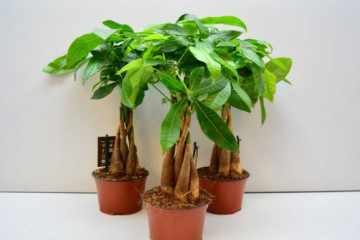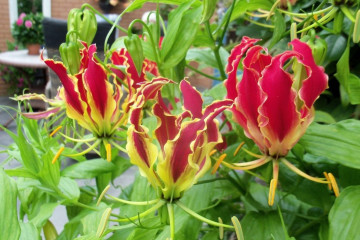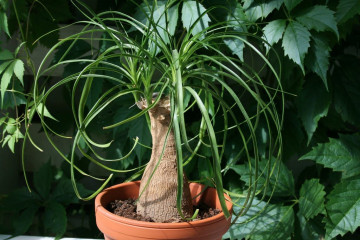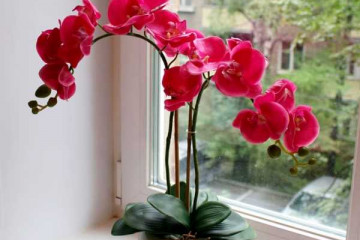Nolina: home care and transplant examples
Content:
This tropical plant is a distant relative of the agave. More recently, it was considered exotic. Recently, however, domestic flower growers often use nolin to decorate the interior. It pleases the eye with an openwork plexus of feathery leaves and does not require much attention. The flower actively receives liquid from the atmosphere and does not require intensive watering, unlike other southern "guests".
Main varieties
The most popular varieties of potted flower pot are:
- Bocarnea;
- Rekurvata;
- Stamp;
- Compressed.
There are other varieties, but they are less common in Russia.
Bocarnea
Nolina Bocarnea is one of the most beautiful varieties. The dark green leaves of an emerald hue form a compact crown. The trunk has a dense thickening at the bottom. The height of an adult plant can reach 1.7 m at home.
Recurvata
Nolina Recurvata has narrow arrow-like leaves of a beautiful dark green color. Translated from Latin, this name means "bent". The variety received this name because of the characteristic arched shape of the thin leaves. They bend down and fall in a beautiful cascade.
Stamper
Shtambovaya is the most unpretentious variety of the nolin plant. This variety has a lush crown and a bottle-shaped trunk. The disadvantage of this variety is that it grows and develops very slowly, even with proper care and conditions. The land for Nolina shtambova must be fertile.
Others
In domestic flower shops, you can also buy nolina thin and Guatemalan. These varieties are more demanding on the chemical composition of the soil. They are compact and grow at home up to a maximum of 1.2 m.
Home care
Care for the potted potted flower is easy. Compared to cacti, this plant is considered less demanding. Nolina home care is:
- Watering;
- Transfer;
- Loosening the soil;
- Top dressing.
The plant does not require pruning. Reproduction of nolina is carried out by lateral processes.
Lighting and location
The ideal place for a flower is on the south window, where the sun is constantly shining. The plant is not afraid of direct natural light, but does not tolerate partial shade. If there is little light, this can lead to deformation of the trunk (its elongation).
The soil
The soil is perfect for cacti, because nolina is a distant "relative" of succulents. You can also prepare a mixture of peat, leafy earth, river sand with your own hands. A little charcoal is added as an absorbent. As a soil for nolina, it is recommended to use purchased land for ornamental plants so as not to infect the flower with pests or parasites.
Watering
Standard nolina needs more frequent watering compared to other varieties. In winter, when a flower enters a period of physiological dormancy, it does not need moisture at all. It is best to pour the liquid into a pan to prevent waterlogging of the soil. The plant absorbs moisture on its own.If surplus remains, they are carefully drained.
Top dressing
The flower is fed in spring and summer, once a month, with mineral complex fertilizers for succulents. Periodically, mineral nutrition is alternated with organic. The concentration should be half the value indicated on the package.
Temperature and humidity
The flower grows poorly in high humidity and thrives in winter when the air is dry, thanks to the work of central heating. Nolina needs to be protected from drafts and sudden temperature changes. If the house is cold, a heater should be installed in the apartment.
Plant transplant
Burbot is an indoor flower that grows quickly under the right conditions, so timely transplantation is of great importance. Every amateur florist should know how to transplant nolin at home. Helpful hints:
- The recommended transplant frequency is once every three years;
- After the procedure, the plant is not watered for at least five days;
- The new pot should not be too spacious so that the roots do not rot;
- The thickened part of the trunk must not be buried in the ground. This can lead to the death of the plant.
Young flowers are transplanted annually.
Reproduction methods
All varieties of nolina are indoor flowers, the care of which is simple and does not take much time. However, reproduction is a more laborious process, and it is not easy to grow this flower from a seed. Even high-quality seed does not guarantee good germination.
Seeds
When growing nolina from seeds, the first shoots require a very careful attitude. To get seedlings, the seed is soaked in potassium permanganate for disinfection. After that, a loose soil with river sand is prepared. The recommended sowing depth is no more than 1 cm, otherwise the sprouts will not appear. The seeds are covered with a thin layer of earth and placed under glass or film. Shoots should be expected in three weeks. When three leaves appear on each shoot, the specimen is planted in a separate pot. Caring for young growth is no different from caring for adults. The main thing is to provide good illumination and prevent root rot caused by abundant watering.
Lateral processes
In nolina, reproduction is possible not only by seeds. It also reproduces by lateral layers. This requires:
- With a sharp knife, carefully separate the process from the adult specimen;
- Leave in the fresh air for half a day;
- Remove the lower small leaves;
- Soak in growth stimulant solution;
- Plant in the ground under a jar or glass.
When the process takes root, the cap can be safely removed. In order for the plant to quickly adapt to the new environment, it must be planted in a special purchased soil for cacti. The newly planted cut must be protected from direct sunlight.
Possible problems
Nolina is a flower that is rarely affected by diseases and pests. However, with high air humidity, the plant can be occupied by spider mites. Dealing with this problem is quite simple: you need to reduce watering and increase the air temperature in the room. In winter, you can use the sources of additional lighting and heating.
The leaves fell down
It happens that the leaves of the nolina palm unexpectedly fall down. This is a very alarming sign of irreversible changes. If the leaves have dropped, then the trunk has lost its elasticity. In this case, it is not possible to reanimate the flower; most likely, it is already dead.The death of the stem means the death of the plant, because it is through the thickened stem of the nolin that most of the nutrients are absorbed. Reinforced top dressing will no longer help.
Others
It happens that during transplantation, the florist notices the roots affected by the fungus. In this case, they are carefully trimmed before placing the nolina in a new vessel. Timely removal of decayed areas is guaranteed to save the flower from death, therefore, with each transplant, the roots must be carefully examined. In adult specimens, the roots are more often affected by the fungus, compared to young shoots.
The insidiousness of fungal infections is that they are asymptomatic and become noticeable already in the last stages. Therefore, when growing nolina, you should pay special attention to the watering regime.
It is necessary to organize home care for Nolina in such a way as to prevent waterlogging of the earth - this is fraught with the occurrence of fungal root diseases. The soil in the pot intended for nolina should never be wet; a layer of drainage is needed to quickly absorb moisture at the bottom of the pot.
With proper care, nolin will actively develop and grow for a long time. This unusual flower will decorate the interior of your home and office, and will also help purify the air in any room. Also, it can be safely grown in a house where there are children - the tree never causes allergic reactions. However, the plant takes up a lot of space, so it is not suitable for a small apartment.
Video
